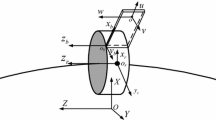Abstract
Aero-engine blades often fracture failed due to resonance. In order to analyze the vibration characteristics of high-speed rotating blades of aero-engine more accurately, not only the out-of-plane deformation and in-plane deformation, but also the in-plane deformation caused by out-of-plane deformation are taken into account in the process of research on the rigid-flexible coupling dynamics of blade. The study using the hypothetical modal method to describe the deformation of the blade and using the Lagrangian dynamics equation to establish the first-order approximation coupled dynamics equation of the flexible blade with three-dimensional large displacement motion. The simulation results show that the theoretical results of the first approximation coupling model are consistent with the actual results, but the zero-order approximation coupling model is flawed when the blade speed is high. Based on the first-order approximation coupling model, the vibration frequency, frequency-steering and mode-switching problems of the blade are analyzed, and the feasibility of the proposed method is verified.
Similar content being viewed by others
References
H. H. Yoo and J. Chung, Dynamics of rectangular plate, Journal of Sound and Vibration, 239(1) (2001) 123–137.
T. R. Kane, R. R. Ryan and A. K. Banerjee, Dynamics of a cantilever beam attached to a moving base, Journal of Guidance, Control and Dynamics, 10(2) (1987) 139–151.
R. Q. Zhang and J. S. Weng, Blade flutter analysis based on fluid solid coupling, Computer Simulation, 28(3) (2011) 48–51, 76.
S. B. Wu, D. G. Zhang and X. Kang, Dynamic properties of hub-micro beam system, Journal of Mechanical Engineering, 46(3) (2010) 76–82.
J. Li et. al., ADAMS Instance Tutorial, Beijing University of Science and Technology Press, Beijing, China (2002).
L. M. Wu and S. Q. Cao, Analysis of vibration characteristics of blade under rotor motion, Journal of Mechanical Engineering, 55(19) (2019) 92–102.
H. L. Xu et al., Compressed sensing-based blind reconstruction of multi-frequency blade vibration from under-sampled BTT signals, Journal of Mechanical Engineering, 55(13) (2019) 113–121.
J. W. Lin et al., Aero-engine blade fatigue analysis based on nonlinear continuum damage model using neural networks, Chinese Journal of Mechanical Engineering, 26(2) (2012) 1879–1886.
Z. Yun, C. Z. Tong and N. Tao, Reverse modeling strategy of aero-engine blade based on design intenl, The International Journal of Advanced Manufacturing Technology, 81(9–12) (2015) 1781–1796.
F. Brahimi and A. Ouibrahim, Blade dynamical response based on aeroelastic analysis of fluid structure interaction in turbomachinery, Energy, 115 (2016) 986–995.
A. E. Khalifa, A. M. Al-Qutub and R. Ben-Mansour, Study of pressure fluctuations and induced vibration at blade-passing frequencies of a double volute pump, Arabian Journal for Science and Engineering, 36(7) (2011) 1333–1345.
K. W. Barlow and R. Chandra, Fatigue crack propagation simulation in an aircraft engine fan blade attachment, International Journal of Fatigue, 27(10–12) (2005) 1661–1668.
S. Linqi et al., The effect of cooling conditions on convective heat transfer and flow in a steam-cooled ribbed duct, Journal of Mechanical Science and Technology, 28(1) (2014) 331–341.
Q. He, H. J. Xuan and L. L. Liu, Numerical analysis of real aero-engine first-stage fan blade containment, Hangkong Dongli Xuebao/Journal of Aerospace Power, 27(2) (2012) 295–300.
D. Kececioglu and W. Wang, On the lower confidence limit of the calculated reliability for mechanical components and structural members, 38th Structures, Structural Dynamics, and Materials Conference, New York, USA (1997).
S. Lee et al., Multi-disciplinary design optimization and performance evaluation of a single stage transonic axial compressor, Journal of Mechanical Science and Technology, 27(11) (2013) 3309–3318.
W. Duan and Z. Wang, Vibration reliability analysis of turbine blade based on response surface method, Zhendong Ceshi Yu Zhenduan/Journal of Vibration, Measurement and Diagnosis, 32(1) (2010) 1–4.
A. Mikolajczak et al., Advances in fan and compressor blade flutter analysis and predictions, Journal of Aircraft, 12(4) (1975) 325–332.
Q. K. Han et al., Simulations of a dual-rotor system with local rub-impacts based on rigid-flexible multi-body model, Key Engineering Materials, 413–414 (2009) 677–682.
J. Yuan et al., Novel parametric reduced order model for aeroengine blade dynamics, Mechanical Systems and Signal Processing, 62–63(10) (2015) 235–253.
Z. L. Luo et. al., Considering the requirements of static strength for the rotating straight blade similar experimental model design method, Journal of Mechanical Engineering, 52(9) (2016) 79–85.
X. L. Yao, Structural Dynamics, Harbin Engineering University Press, Harbin, China (2007).
Acknowledgments
The support of this work by National Natural Science Foundation of China (No. 51975386), National Key R&D Program of China (No. 2019YFB1705000, 2020YFB2007800) and Liaoning Xingliao Program (No. XLYC1907200) are gratefully acknowledged.
Author information
Authors and Affiliations
Corresponding author
Additional information
Wei Zhe is a Professor at the School of Mechanical Engineering, Shenyang University of Technology, Shenyang, China. He received his Ph.D. from Zhejiang University. His research interests include intelligent design and intelligent manufacturing.
Li Li is an Associate Professor at the School of Mechanical Engineering, Shenyang University of Technology, Shenyang, China. She received her Ph.D. from Northeastern University. Her research interests include intelligent design and industry design.
Zhao Fang is a Professor at the School of Mechanical Engineering, Shenyang University of Technology, Shenyang, China. She received her Master’s degree from Huazhong University of Science and Technology. Her research interests include intelligent design and industry design.
Rights and permissions
About this article
Cite this article
Wei, Z., Li, L. & Zhao, F. First-order approximate rigid-flexible coupled dynamics analysis of a simple aero-engine blade model with dynamic stiffening effect. J Mech Sci Technol 35, 2997–3003 (2021). https://doi.org/10.1007/s12206-021-0623-z
Received:
Revised:
Accepted:
Published:
Issue Date:
DOI: https://doi.org/10.1007/s12206-021-0623-z



